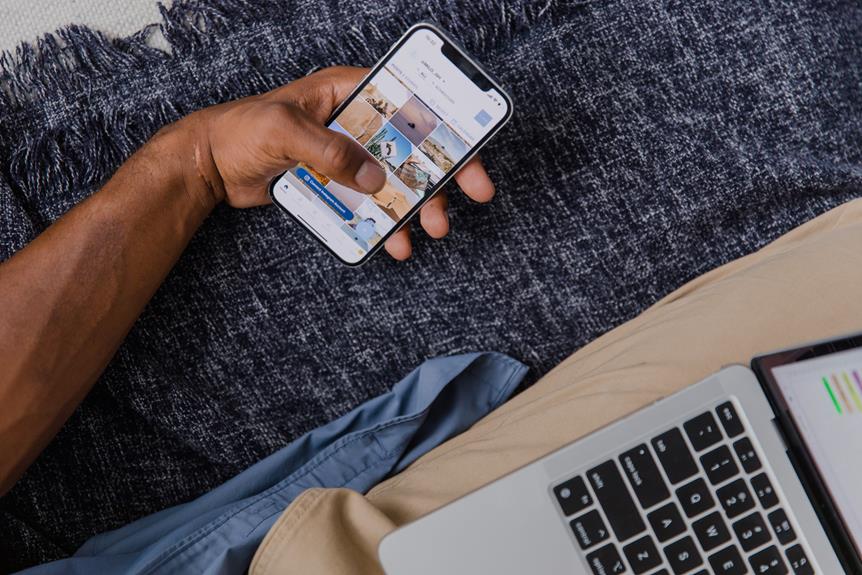Imagine a world where a mobile phone becomes more than just a device, but a beacon of accessibility, independence, and empowerment for visually impaired individuals. With the advancements in technology, mobile phones have transformed into powerful tools designed to cater to the unique needs of the visually impaired. From screen readers that bring text to life, to voice control that allows for seamless navigation, these devices open up a whole new world of possibilities. But it doesn't stop there. Join us as we explore the fascinating world of mobile phones for the visually impaired, where innovation meets inclusivity, and where the possibilities are endless.
Key Takeaways
- Specialized phones like BlindShell Classic 2 and MiniVision2 offer improved accessibility features and tactile keypad for easier navigation.
- Mainstream options like iPhones and Android devices provide accessibility features such as screen readers, screen magnifiers, and AI-generated image descriptions.
- Major cell phone carriers offer accessibility features and it is recommended to research specific phone models and visit stores to examine accessibility options.
- Phones for the visually impaired have features like talk and text capabilities, internet and email access, zoom functionality, voice commands, caller ID, and call history.
BlindShell Classic 2 Cell Phone
The BlindShell Classic 2 Cell Phone offers a sleek design and improved accessibility features, making it a reliable and compact option for the visually impaired. This accessible cell phone, also known as a feature phone, is specifically designed to cater to the needs of individuals with visual impairments. With its physical buttons and tactile keypad, navigating the phone becomes easier and more intuitive. The larger screen size and enhanced voice control functionality further enhance the user experience.
One of the standout features of the BlindShell Classic 2 is its screen reader, which reads out the text on the screen, allowing visually impaired users to easily access information. Additionally, the phone supports voice commands, enabling users to make calls, send text messages, and access various applications hands-free. These accessibility features greatly enhance the independence and functionality of the phone for visually impaired individuals.
Furthermore, the BlindShell Classic 2 offers a range of useful apps for daily life, such as talk, text, internet, Zoom, and email. With these apps, users can stay connected with family and doctors, send messages, and access the internet for information and entertainment. The phone also supports voice dictation, making it easier for users to compose messages and notes.
MiniVision2: Simple Cell Phone
Introducing the MiniVision2, a simple cell phone designed with accessibility in mind. This phone is a game-changer for people with visual impairments, as it offers a range of features that make it easy to use and navigate. The large, well-spaced buttons and tactile cues ensure that blind users can easily find and press the right buttons without any difficulty.
One of the standout features of the MiniVision2 is its voice guide. This guide speaks everything on the screen, providing status information and supporting over 20 languages. With adjustable speed and volume, users can customize the voice to suit their preferences. In addition, the phone allows for hands-free operation through voice commands. Users can make calls, send messages, open apps, and even create voice memos all through the power of their voice.
Making calls is a breeze on the MiniVision2. Users can choose from multiple methods, including entering digits, using contacts, call history, and voice commands. Incoming message notifications are also read aloud, ensuring that blind users never miss an important message.
The MiniVision2 goes beyond just voice accessibility. It also includes features like adjustable display brightness, a removable back panel, and compatibility with voice dictation. These additional accessibility features enhance the overall functionality and ease of use for people with visual impairments.
Phones for People With Visual Impairments
Now let's explore the world of phones specifically designed for people with visual impairments. These phones offer a range of features and accessibility options to assist individuals who are blind or have low vision in navigating the digital world.
One option is the BlindShell Classic 2 phone, which combines a sleek design with enhanced voice control. It also offers compatibility with various applications such as Zoom and Spotify, providing a well-rounded experience for users.
Another phone designed with visual impairments in mind is the MiniVision2. This phone features large, well-spaced buttons and adjustable display brightness for improved visibility. It also includes voice guide and commands for basic tasks like making calls and sending messages, making it user-friendly and accessible.
In addition to these specialized phones, mainstream options like iPhones and Android devices also offer helpful features for people with visual impairments. These include screen readers, screen magnifiers, and AI-generated image descriptions, enhancing accessibility for a wider range of users.
It's worth noting that major cell phone carriers like Verizon, AT&T, T-Mobile, and Sprint also offer accessibility features for people with visual impairments. However, it's important to research specific phone models and visit stores to examine the accessibility options available.
Phones for the Blind and Visually Impaired
Phones designed specifically for the blind and visually impaired offer a range of features and accessibility options that enhance functionality and promote inclusivity. These phones are tailored to meet the unique needs of individuals with visual impairments, providing them with essential tools to stay connected and engaged with the world around them. Here are some key features offered by these phones:
- Talk and text capabilities: These phones allow users to communicate through voice calls and text messages, ensuring that they can stay in touch with their loved ones and access important information.
- Internet and email access: With internet and email capabilities, visually impaired individuals can browse the web, send and receive emails, and access online resources, empowering them to stay informed and connected.
- Zoom functionality: These phones often include a zoom feature, enabling users to enlarge text and images on the screen, making it easier for them to read and navigate through their phone's interface.
- Voice commands: By using voice commands, individuals who are blind or visually impaired can make calls, send messages, open apps, and perform other tasks on their phone, providing them with a hands-free and convenient experience.
- Caller ID and call history: The phones for the blind and visually impaired are equipped with caller ID that reads incoming calls aloud, allowing users to identify callers. Additionally, they provide access to call history, enabling users to review and return missed calls.
These useful features, offered by major cell phone providers, ensure that individuals with visual impairments can fully utilize a smartphone and enjoy the benefits of modern technology.
Mainstream Phones With Helpful Features
Mainstream phones today offer a wide range of helpful features specifically designed to assist visually impaired individuals in their daily tasks and communication. These accessible phones are equipped with built-in accessibility features that cater to the unique needs of visually impaired phone users. For instance, both iPhone and Android phones come with screen readers like VoiceOver and TalkBack, respectively. These screen readers use synthesized speech to read out text on the screen, making it easier for visually impaired individuals to navigate menus, compose messages, and browse the internet. Additionally, mainstream phones provide options for high contrast and tactile feedback, allowing users to customize their device according to their preferences and enhancing visibility for those with visual impairments.
Moreover, mainstream phones are compatible with various accessibility apps that further enhance their functionality for visually impaired users. Apps like Be My Eyes, Seeing AI, and Braille input apps provide additional support, such as object recognition, text-to-speech capabilities, and braille input options. These features promote inclusivity and independence, enabling visually impaired individuals to perform daily tasks with ease.
In terms of design, mainstream phones prioritize sleek and elegant aesthetics, ensuring that visually impaired individuals can have a stylish device that meets their accessibility needs. The combination of helpful features, accessibility apps, and sleek design makes mainstream phones a valuable tool for visually impaired individuals, empowering them to stay connected, informed, and independent in today's digital world.
Accessible Phone Options
With a variety of accessible phone options available, visually impaired individuals can now choose devices that cater to their specific needs and enhance their everyday communication and tasks. Here are some features and options to consider when selecting an accessible phone:
- The BlindShell Classic 2 offers a sleek design and improved tactile keypad, making it easy to navigate. It also has a larger screen and enhanced voice control functionality, allowing users to operate the phone using their voice.
- The MiniVision2 features large, well-spaced buttons with tactile cues, making it easier for visually impaired individuals to locate and press the right buttons. It also has adjustable display brightness and a removable back panel for easy SIM card and micro SD card access.
- Both the BlindShell Classic 2 and the MiniVision2 have features that convert the phone into a talking device for blind users. They provide status information and speak everything on the screen, supporting multiple languages and allowing users to adjust the speed and volume.
- Mainstream phones like iPhones and Android devices also offer accessibility features such as VoiceOver, screen magnifiers, and AI-generated image descriptions. These features cater to the diverse needs of visually impaired users.
- Finally, when selecting an accessible phone, consider the operating system, customer support, and ease of use. Some individuals may prefer physical buttons, while others may rely on voice commands. Additionally, features like fully accessible phone numbers and speed dialing can greatly enhance the user experience.
With these accessible phone options, visually impaired individuals can confidently communicate and stay connected with the world around them.
Frequently Asked Questions
What Is the Best Mobile Phone for Visually Impaired People?
The best mobile phone for visually impaired people is the BlindShell Classic 2. It offers a sleek design, improved tactile keypad, voice control functionality, and compatibility with essential apps. It also comes with necessary accessories and dedicated customer support.
Are There Cell Phones for the Visually Impaired?
Yes, there are cell phones designed specifically for the visually impaired. These phones offer features like tactile keypads, voice guides, screen readers, and accessibility apps to enhance their user experience and inclusivity.
What Is the Best Smartphone for People With Bad Eyesight?
The best smartphone for people with bad eyesight is one that offers accessibility features like voice control, screen readers, and magnifiers. These features allow users to navigate and operate the phone easily, promoting inclusivity and independence.
What Is the Best Cell Phone for Someone With Macular Degeneration?
The best cell phone for someone with macular degeneration is the BlindShell Classic 2. It has a tactile keypad, voice control, large buttons, adjustable display brightness, and compatibility with accessibility apps. It also comes with essential accessories for convenience.
Conclusion
In conclusion, mobile phones for visually impaired individuals have revolutionized accessibility and independence. With features like screen readers, magnifiers, and voice control, these phones provide a lifeline for those with visual impairments. They not only enhance communication but also offer a sense of security and emergency assistance. Whether it's the BlindShell Classic 2, MiniVision2, or mainstream phones with helpful features, there are accessible phone options available for everyone. These phones truly empower visually impaired individuals to navigate their world with confidence and ease.

